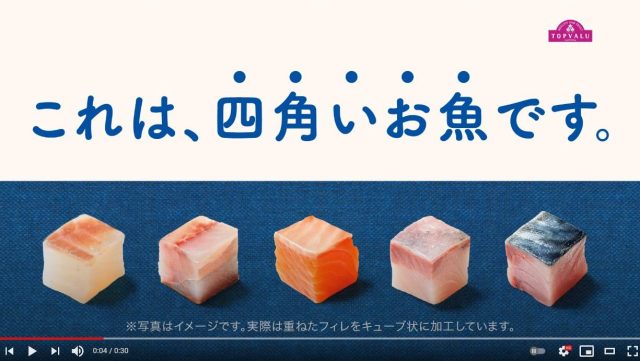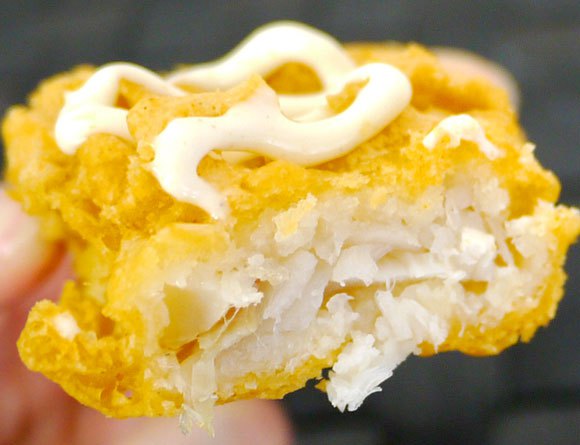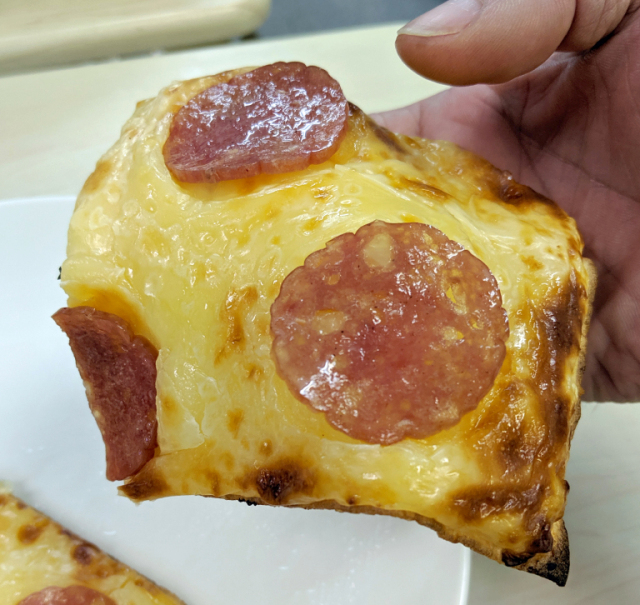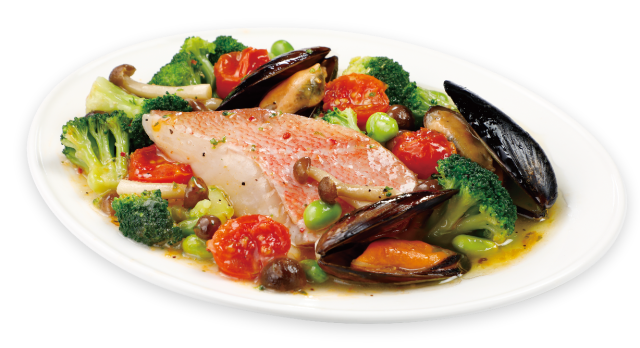
Everything tastes better when it’s a cube!
It’s certainly no secret that Japan is a country that loves to eat fish and in a variety of ways from sushi to soups to a nice grilled filet. But it might surprise some to learn that by and large people here don’t really go for the taste of the humble fish stick or “fish finger” if you will.
Heavily processed and battered white fish meat does exist in Japan, mainly as a cheap bento side dish and in the Filet-O-Fish at McDonald’s. That’s about the limit that it’s tolerated though, with supermarket freezer sections only offering a smattering of frozen processed fish meat.
▼ KFC also flirted with Kentucky Fried Fish, but it never stuck around

It’s not terribly clear why this is. Some might say it’s a general awareness of food quality that causes people in Japan to stay away from conglomerated meats from unclear origins. However, chicken nuggets are everywhere despite being made in a very similar manner, so people here clearly aren’t that averse to highly processed foods.
▼ Heck, we even found fish meat that had been processed into a pepperoni pizza, now that’s processing!

More likely it’s just a conception of what fish “should” be in the minds of Japanese diners. To draw comparisons, it might be like how a lover of pork ribs might flinch at the concept of Spam. Or more universally, fish sticks to Japanese people might be seen the same way that anyone would view eating processed broccoli sticks coated in bread. That probably wouldn’t taste so bad, but most people’s initial reaction to it would probably be to ask; “Why even bother doing this?”
▼ The Japanese standard for fish served with the global standard for broccoli
However, eating unprocessed fish has its drawbacks. It’s full of bones that are a nuisance at best and dangerous at worst. It can be time consuming and messy to cook and leave a less-than-pleasant smelling amount of waste when finished.
According to major retailer Aeon, who also runs a number of supermarket chains, these issues, combined with a drastic increase in home cooking due to COVID-19, have led to an increased demand for a simpler way to cook fish. These are the perfect conditions for fish sticks to finally dominate in Japan, right?
Wrong!
Aeon instead went to great lengths to develop fish meat that was both minimally processed but easy to cook and eat. The fruits of this labor is Papatto Dekiru Osakana Okazu (“Fish Side Dish In a Jiffy”) which is sold under Aeon’s Top Valu store brand and available in five types of fish: Pacific cod, horse mackerel, salmon, yellowtail, and chub mackerel.
Despite their very inorganic shape, this meat undergoes the bare minimum of processing, if you would even call it “processing.” In a nutshell, the bones are removed from the fish filets which are then stacked into a layered sheet and pressed together while freezing, with no binding agent used at all.
These frozen sheets of fish are then cut up into cubes, dusted with flour and packaged. It’s all much easier said than done, because getting the different cuts of fish to merge as one and stay that way throughout thawing and cooking took a lot of trial and error. In the end though, Aeon says that this method ended up using more of the fish’s meat and ultimately reduced waste, because even the thinner meat near the tail of the fish was usable this way.
The result is a boneless bite-size cut of fish that only needs to be plopped into a frying pan to cook. Aeon is hoping that this simplicity will encourage home cooks to experiment more with dishes using fish such as pastas and salads.
These fish cubes have only hit seafood sections on 12 May for about 358 yen (US$3.26) a pack, so it remains to be seen if they’ll catch on. If the day ever comes that we see skilfish or warasubo sold in cubes, it’ll probably be safe to say that it was a success.
Source: Top Value, FNN Prime Online, PR Times
Top image: YouTube/トップバリュ公式チャンネル【TOPVALU】
Insert images: PR Times (Unless otherwise stated)
● Want to hear about SoraNews24’s latest articles as soon as they’re published? Follow us on Facebook and Twitter!




 Japanese Filet-O-Fish to get first upgrade in 25 years
Japanese Filet-O-Fish to get first upgrade in 25 years McDonald’s Japan’s first-ever rice fish burger is here, but was it worth the wait?【Taste test】
McDonald’s Japan’s first-ever rice fish burger is here, but was it worth the wait?【Taste test】 Japanese people list their top ten fish, and tuna isn’t number one
Japanese people list their top ten fish, and tuna isn’t number one Rare Fish Festival in Tokyo serves up dishes so good that oil may leak from your anus!
Rare Fish Festival in Tokyo serves up dishes so good that oil may leak from your anus! Japanese ad’s swimming salmon cutlets confuse, educate children about dinner comes from【Video】
Japanese ad’s swimming salmon cutlets confuse, educate children about dinner comes from【Video】 Japan’s new difficult-to-drink-from beer glass protects your liver, but it’s a brutal experience
Japan’s new difficult-to-drink-from beer glass protects your liver, but it’s a brutal experience Demon Slayer: Kimetsu no Yaiba gets new roller coaster attractions and food at Universal Studios Japan
Demon Slayer: Kimetsu no Yaiba gets new roller coaster attractions and food at Universal Studios Japan New Pokémon ice cream, dessert drinks, and cool merch coming to Baskin-Robbins Japan【Pics】
New Pokémon ice cream, dessert drinks, and cool merch coming to Baskin-Robbins Japan【Pics】 Hello, cosmetics! Clinique teams up with Hello Kitty this summer for first-time collaboration
Hello, cosmetics! Clinique teams up with Hello Kitty this summer for first-time collaboration New Nintendo Lego kit is a beautiful piece of moving pixel art of Mario and Yoshi【Photos】
New Nintendo Lego kit is a beautiful piece of moving pixel art of Mario and Yoshi【Photos】 Caffeinated ramen for gamers that you can eat with one hand going on sale in Japan
Caffeinated ramen for gamers that you can eat with one hand going on sale in Japan How to order snacks on a Shinkansen bullet train in Japan
How to order snacks on a Shinkansen bullet train in Japan New samurai glasses are Japan’s latest weird must-have souvenir
New samurai glasses are Japan’s latest weird must-have souvenir High-fashion Totoro cuddle purse is like an elegant stroll in the forest【Photos】
High-fashion Totoro cuddle purse is like an elegant stroll in the forest【Photos】 Swords of famous samurai reborn as beautiful kitchen knives from Japan’s number-one katana town
Swords of famous samurai reborn as beautiful kitchen knives from Japan’s number-one katana town Nintendo history you can feel – Super NES, N64, and GameCube controllers become capsule toys
Nintendo history you can feel – Super NES, N64, and GameCube controllers become capsule toys “The most Delicious Cup Noodle in history” – Japan’s French Cup Noodle wins our heart【Taste test】
“The most Delicious Cup Noodle in history” – Japan’s French Cup Noodle wins our heart【Taste test】 Starbucks releases a cute Frappuccino and Unicorn Cake…but not in Japan
Starbucks releases a cute Frappuccino and Unicorn Cake…but not in Japan Kyoto Tower mascot termination reveals dark side behind cute Japanese characters
Kyoto Tower mascot termination reveals dark side behind cute Japanese characters McDonald’s Japan’s Soft Twist Tower: A phantom ice cream only sold at select branches
McDonald’s Japan’s Soft Twist Tower: A phantom ice cream only sold at select branches Yabai Ramen: What makes this Japanese ramen so dangerous?
Yabai Ramen: What makes this Japanese ramen so dangerous? Finally! Nintendo Japan expands Switch 8-bit controller sales to everybody, Online member or not
Finally! Nintendo Japan expands Switch 8-bit controller sales to everybody, Online member or not Japanese government wants to build luxury resorts in all national parks for foreign tourists
Japanese government wants to build luxury resorts in all national parks for foreign tourists To combat declining birth rate, Japan to begin offering “Breeding Visas” to foreigners
To combat declining birth rate, Japan to begin offering “Breeding Visas” to foreigners 10 things you should buy at 7-Eleven in Japan
10 things you should buy at 7-Eleven in Japan Studio Ghibli releases anime heroine cosplay dresses that are super comfy to wear
Studio Ghibli releases anime heroine cosplay dresses that are super comfy to wear Woman charged for driving suitcase without a license in Osaka
Woman charged for driving suitcase without a license in Osaka Studio Ghibli unveils My Neighbour Totoro miniature house model
Studio Ghibli unveils My Neighbour Totoro miniature house model Kyoto experiencing problems with foreign tourists not paying for bus fares, but not on purpose
Kyoto experiencing problems with foreign tourists not paying for bus fares, but not on purpose Fighting mild hunger with a Japanese soda that turns into jelly in the stomach【Taste test】
Fighting mild hunger with a Japanese soda that turns into jelly in the stomach【Taste test】 Studio Ghibli’s Howl’s Moving Castle tapestry unveiled in Japan for first time
Studio Ghibli’s Howl’s Moving Castle tapestry unveiled in Japan for first time McDonald’s new Happy Meals offer up cute and practical Sanrio lifestyle goods
McDonald’s new Happy Meals offer up cute and practical Sanrio lifestyle goods Sales of Japan’s most convenient train ticket/shopping payment cards suspended indefinitely
Sales of Japan’s most convenient train ticket/shopping payment cards suspended indefinitely Sold-out Studio Ghibli desktop humidifiers are back so Totoro can help you through the dry season
Sold-out Studio Ghibli desktop humidifiers are back so Totoro can help you through the dry season Japanese government to make first change to romanization spelling rules since the 1950s
Japanese government to make first change to romanization spelling rules since the 1950s Foreigner’s request for help in Tokyo makes us sad for the state of society
Foreigner’s request for help in Tokyo makes us sad for the state of society Ghibli founders Toshio Suzuki and Hayao Miyazaki contribute to Japanese whisky Totoro label design
Ghibli founders Toshio Suzuki and Hayao Miyazaki contribute to Japanese whisky Totoro label design Doraemon found buried at sea as scene from 1993 anime becomes real life【Photos】
Doraemon found buried at sea as scene from 1993 anime becomes real life【Photos】 Tokyo’s most famous Starbucks is closed
Tokyo’s most famous Starbucks is closed Princesses, fruits, and blacksmiths: Study reveals the 30 most unusual family names in Japan
Princesses, fruits, and blacksmiths: Study reveals the 30 most unusual family names in Japan “You will need courage!”: We try a sweetfish hot dog
“You will need courage!”: We try a sweetfish hot dog Moby Drink: Iceland creates a beer made with endangered whale bones, can’t sell it
Moby Drink: Iceland creates a beer made with endangered whale bones, can’t sell it Top 10 food disasters prepared by Japanese wives who have extraordinary talent in the kitchen
Top 10 food disasters prepared by Japanese wives who have extraordinary talent in the kitchen Japan develops special sushi for pregnant women
Japan develops special sushi for pregnant women We have Norway to thank for salmon sushi and they’re planning even more for Good Meat Day
We have Norway to thank for salmon sushi and they’re planning even more for Good Meat Day How to choose a great block of sashimi-grade tuna – 66-year maguro master shares his protips
How to choose a great block of sashimi-grade tuna – 66-year maguro master shares his protips Japan’s biggest ham company is making “tuna” that contains neither ham nor fish
Japan’s biggest ham company is making “tuna” that contains neither ham nor fish Japanese cook creates adorable meal of “cats” feasting on fish!
Japanese cook creates adorable meal of “cats” feasting on fish! Yaizu: Japan’s best sushi market destination even most foodies in Japan have never heard of
Yaizu: Japan’s best sushi market destination even most foodies in Japan have never heard of Kura Burger: Japanese sushi chain restaurant offers burgers in Tokyo for a limited time
Kura Burger: Japanese sushi chain restaurant offers burgers in Tokyo for a limited time Cup Noodle makers successfully create lab-grown diced steak with authentic texture
Cup Noodle makers successfully create lab-grown diced steak with authentic texture Salmon-flavored Puccho candy – disgusting or delightful? 【Taste test】
Salmon-flavored Puccho candy – disgusting or delightful? 【Taste test】 Miso soup capsule toys look good enough to eat, come with recipes to make the real thing!【Photos】
Miso soup capsule toys look good enough to eat, come with recipes to make the real thing!【Photos】 Sushi chain bento combines raw fish with…sukiyaki?
Sushi chain bento combines raw fish with…sukiyaki? Make your tummy happy, eat a kimchi yogurt rice bowl today
Make your tummy happy, eat a kimchi yogurt rice bowl today
Leave a Reply